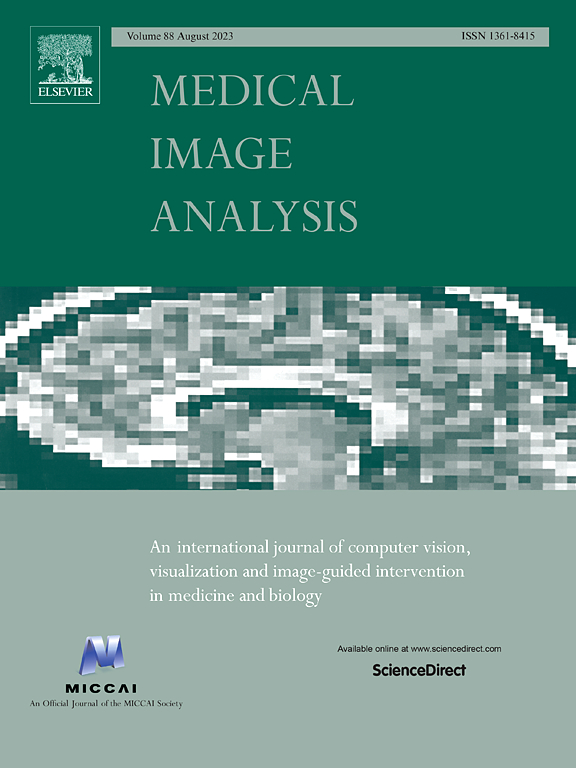Preoperative fracture reduction planning for image-guided pelvic trauma surgery: A comprehensive pipeline with learning
IF 10.7
1区 医学
Q1 COMPUTER SCIENCE, ARTIFICIAL INTELLIGENCE
引用次数: 0
Abstract
Pelvic fractures are among the most complex challenges in orthopedic trauma, which usually involve hipbone and sacrum fractures, as well as joint dislocations. Traditional preoperative surgical planning relies on the operator’s subjective interpretation of CT images, which is both time-consuming and prone to inaccuracies. This study introduces an automated preoperative planning solution for pelvic fracture reduction, addressing the limitations of conventional methods. The proposed solution includes a novel multi-scale distance-weighted neural network for segmenting pelvic fracture fragments from CT scans, and a learning-based approach to restore pelvic structure, combining a morphable model-based method for single-bone fracture reduction and a recursive pose estimation module for joint dislocation reduction. Comprehensive experiments on a clinical dataset of 30 fracture cases demonstrated the efficacy of our methods. Our segmentation network outperformed traditional max-flow segmentation and networks without distance weighting, achieving a Dice similarity coefficient (DSC) of 0.986 ± 0.055 and a local DSC of 0.940 ± 0.056 around the fracture sites. The proposed reduction method surpassed mirroring and mean template techniques, and an optimization-based joint matching method, achieving a target reduction error of (3.265 ± 1.485) mm, rotation errors of (3.476 ± 1.995)°, and translation errors of (2.773 ± 1.390) mm. In the proof-of-concept cadaver studies, our method achieved a DSC of 0.988 in segmentation and 3.731 mm error in reduction planning, which senior experts deemed excellent. In conclusion, our automated approach significantly improves traditional preoperative planning, enhancing both efficiency and accuracy in pelvic fracture reduction.

影像引导骨盆创伤手术的术前骨折复位计划:一个综合的学习管道
骨盆骨折是骨科创伤中最复杂的挑战之一,通常涉及髋骨和骶骨骨折以及关节脱位。传统的术前手术计划依赖于术者对CT图像的主观解读,既耗时又容易出错。本研究介绍了骨盆骨折复位的自动化术前计划解决方案,解决了传统方法的局限性。提出的解决方案包括一种用于从CT扫描中分割骨盆骨折碎片的新型多尺度距离加权神经网络,以及一种基于学习的骨盆结构恢复方法,该方法结合了基于morphable模型的单骨骨折复位方法和用于关节脱位复位的递归姿态估计模块。在30例骨折病例的临床数据集上进行的综合实验证明了我们的方法的有效性。我们的分割网络优于传统的最大流量分割和没有距离加权的分割网络,在裂缝附近的Dice相似系数(DSC)为0.986±0.055,局部DSC为0.940±0.056。该方法超越了镜像、平均模板技术和基于优化的联合匹配方法,实现了目标约简误差(3.265±1.485)mm,旋转误差(3.476±1.995)°,平移误差(2.773±1.390)mm。在概念验证的尸体研究中,我们的方法在分割上的DSC为0.988,在约简规划上的误差为3.731 mm,被高级专家认为是优秀的。总之,我们的自动化方法显著改善了传统的术前计划,提高了骨盆骨折复位的效率和准确性。
本文章由计算机程序翻译,如有差异,请以英文原文为准。
求助全文
约1分钟内获得全文
求助全文
来源期刊

Medical image analysis
工程技术-工程:生物医学
CiteScore
22.10
自引率
6.40%
发文量
309
审稿时长
6.6 months
期刊介绍:
Medical Image Analysis serves as a platform for sharing new research findings in the realm of medical and biological image analysis, with a focus on applications of computer vision, virtual reality, and robotics to biomedical imaging challenges. The journal prioritizes the publication of high-quality, original papers contributing to the fundamental science of processing, analyzing, and utilizing medical and biological images. It welcomes approaches utilizing biomedical image datasets across all spatial scales, from molecular/cellular imaging to tissue/organ imaging.
 求助内容:
求助内容: 应助结果提醒方式:
应助结果提醒方式:


